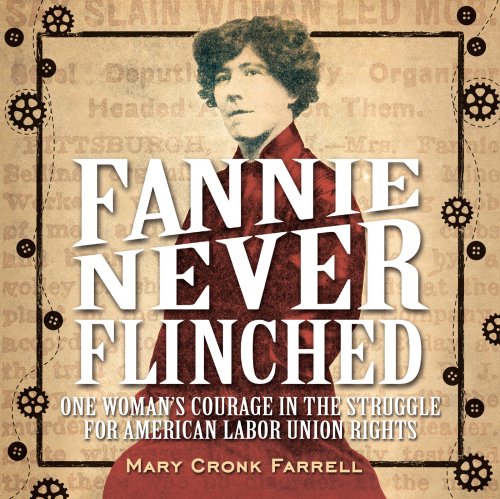
Fannie Never Flinched
One Woman's Courage in the Struggle for American Labor Union Rights
فرمت کتاب
ebook
تاریخ انتشار
2016
Lexile Score
1020
Reading Level
5-8
ATOS
6.2
Interest Level
4-8(MG)
نویسنده
Mary Cronk Farrellناشر
ABRAMSشابک
9781613129722
کتاب های مرتبط
- اطلاعات
- نقد و بررسی
- دیدگاه کاربران
نقد و بررسی

Starred review from September 12, 2016
Farrell (Pure Grit) spotlights little-known activist Fannie Sellins (1867–1919) in an accessible biography that also serves as a valuable introduction to the U.S. labor rights’ movement. Widowed with four children, Sellins worked in garment sweatshops in St. Louis, Mo., at the turn of the 20th century. She successfully united her fellow workers to fight for better wages and working conditions, and went on to do the same for workers in other industries. She butted up against anti-union coal mine owners, and was ultimately killed for the causes she championed. Over six brief chapters, Farrell deftly places Sellins’s story within the larger context of immigration and industrialization at the time. Stitched blue-denim illustrations on the endpapers color coordinate with blue-tinted archival photographs of immigrant workers at sewing machines, in mines, and in company towns. In a nod to Sellins’s work as a seamstress, images of buttons, gears, and stitching help frame each spread. Readers interested in the history of workers’ rights shouldn’t miss this entrée to the subject, which is bolstered by a timeline of labor struggles, source notes, and other resources. Ages 10–14. Agent: Stephen Fraser, Jennifer De Chiara Literary.

Farrell chronicles Fannie Sellins' life as a garment worker, organizer, and martyr for workers' rights at the turn of the 20th century.After Fannie's husband died, leaving her with four children, she sewed in a St. Louis sweatshop. Women and girls worked 10 to 14 hours daily, six days a week, locked in deafening factories where tuberculosis ran rampant. Hearing of the United Garment Workers of America's successes elsewhere, Fannie began organizing co-workers during breaks. In 1902, she helped form the Ladies Local 67 of the UGWA. In 1909, a worker's punishment engendered a walkout, a lockout, a strike, and a boycott. As the local's president, Sellins traveled on the workers' behalf, raising strike fund money in union halls and successfully advancing the boycott. Next, Sellins helped coal miners fight brutal owners in West Virginia, where she was arrested and jailed. Organizing in western Pennsylvania, she was murdered during a fight between strikers and armed deputies. Farrell's text and annotated timeline demonstrate that the early struggle for fair wages, hours, and benefits was rife with setbacks and bloodshed, as owners, government officials, and law enforcement colluded to break strikes and unions. Acknowledging the paucity of material on Sellins, Farrell includes well-captioned period photos and primary documents that deepen readers' context for the workers' exploitation and resistance. A cogent, well-documented, handsomely designed treatment of a heretofore forgotten hero of labor. (author's note, glossary, timeline, quotation notes, sources, websites, bibliography) (Nonfiction. 10-14) COPYRIGHT(1) Kirkus Reviews, ALL RIGHTS RESERVED.

Starred review from October 1, 2016
Gr 4-6-The narrative begins with the murder of Fannie Sellins by deputies in Natrona, PA, in 1919 and then goes back 20 years to when Sellins first started working at the Marx and Haas garment factory and helped form the local United Garment Workers of America (UGWA) in St. Louis. Sellins moved up the UGWA ladder and traveled the country talking about the plight of factory workers: long days, low pay, and unsafe working conditions. Word of Sellins's abilities reached coal country, where she visited. Sellins supported the coal miners' efforts to unionize. When mine owners brought up scabs from the South, she chased their car along the railroad tracks, yelling at them not to break the coal miners' strike. Though there was no justice for her death, her memory lives on in coal country. In her author's note, Farrell details why she wrote about Sellins and discusses the difficulties she faced in finding reliable information about her subject's personal life. The text is matter-of-fact in tone, with captioned black-and-white photos and newsprint ads. The beige background features buttons, cogs, and stitches along the bottom of each page, and the end pages are scraps of seamed blue fabric. VERDICT An essential purchase for public or large school libraries interested in workers' rights and social justice.-Tamara Saarinen, Pierce County Library, WA
Copyright 2016 School Library Journal, LLC Used with permission.

Starred review from October 15, 2016
Grades 5-8 *Starred Review* The author may be addressing this stirring story of early union activist Fannie Sellins (18721919) to middle-schoolers, but the rigor of her approach yields a book with solid scholarly features: a noncondescending glossary, a time line for historical context, recommendations for further reading, and a helpful index. In 1902, Sellins was a widowed mother of four working in a St. Louis sweatshop to support her family when she first heard about the United Garment Workers of America, then in its infancy. She helped to organize her fellow seamstresses, most of whom were recent immigrants working 10 to 14 hours 6 days a week for the grand sum of $5 ($145 in today's currency), into Ladies' Local 67. The threat of a strike resulted in a grudging doubling of wages, and within a few years Sellins was traveling to hot spots around the country to spread the word. She ultimately landed in Pennsylvania coal country, the site of egregious abuses, where her fervor proved fatal: pegged as an agitator, she was shot in the back while trying to herd children away from a melee. Her story, richly illustrated with vintage photographs and documents, fairly leaps off the page, driving home the message that the work she fought for is far from over.(Reprinted with permission of Booklist, copyright 2016, American Library Association.)

























دیدگاه کاربران